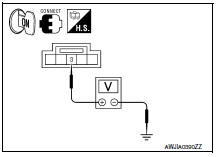Nissan Maxima Service and Repair Manual: Climate controlled seat blower motor
Description
Sends airflow to the seat cushion and seatback.
Component Function Check
1.CHECK CLIMATE CONTROLLED SEAT BLOWER MOTOR FUNCTION
Turn the climate controlled seat switch to the H (Heat) LO, MED, and HI positions and the C (Cool) LO, MED, and HI positions. Check that the climate controlled seat blower motor operates at low, medium and high speed.
Diagnosis Procedure
Regarding Wiring Diagram information, refer to SE-44, "Wiring Diagram".
1.CHECK CLIMATE CONTROLLED SEAT BLOWER MOTOR
Perform climate controlled seat blower motor component inspection. Refer to SE-14, "Component Inspection (Climate Controlled Seat Blower Motor)".
2.CHECK CLIMATE CONTROLLED SEAT BLOWER MOTOR POWER SUPPLY
- Turn ignition switch ON.
- Check voltage between climate controlled seat blower motor connector B220 terminal 2 and ground.


3.CHECK CLIMATE CONTROLLED SEAT BLOWER MOTOR POWER SUPPLY CIRCUIT
- Turn ignition switch OFF.
- Disconnect climate controlled seat blower motor connector and climate controlled seat control unit connector B212.
- Check continuity between climate controlled seat blower motor connector B220 (A) terminal 2 and climate controlled seat control unit connector B212 (B) terminal 7.


4. Check continuity between climate controlled seat blower motor connector B220 (A) terminal 2 and ground.

4.CHECK CLIMATE CONTROLLED SEAT BLOWER MOTOR SPEED CONTROL SIGNAL
Check voltage between climate controlled seat blower motor connector B220 terminal 3 and ground.


5.CHECK CLIMATE CONTROLLED SEAT BLOWER MOTOR SPEED CONTROL SIGNAL CIRCUIT
- Turn ignition switch OFF.
- Disconnect climate controlled seat blower motor connector and climate controlled seat control unit connector B212.
- Check continuity between climate controlled seat blower motor connector B220 (A) terminal 3 and climate controlled seat control unit connector B212 (B) terminal 4.


4. Check continuity between climate controlled seat blower motor connector B220 (A) terminal 3 and ground.

6.CHECK CLIMATE CONTROLLED SEAT BLOWER MOTOR GROUND CIRCUIT
- Turn ignition switch OFF.
- Disconnect climate controlled seat blower motor connector and climate controlled seat control unit connector B212.
- Check continuity between climate controlled seat blower motor connector B220 (A) terminal 4 and climate controlled seat control unit connector B212 (B) terminal 6.


Component Inspection (Climate Controlled Seat Blower Motor)
1.CHECK CLIMATE CONTROLLED SEAT BLOWER MOTOR PART 1
- Turn ignition switch OFF.
- Disconnect climate controlled seat blower motor connector.
- Measure the resistance of the climate controlled seat blower motor between terminals 2 and 4.

2.CHECK CLIMATE CONTROLLED SEAT BLOWER MOTOR PART 2
Measure the resistance of the climate controlled seat blower motor between terminals 3 and 4.

 Power supply and ground circuit
Power supply and ground circuit
CLIMATE CONTROLLED SEAT CONTROL UNIT
CLIMATE CONTROLLED SEAT CONTROL UNIT : Diagnosis Procedure
Regarding Wiring Diagram information, refer to SE-44, "Wiring Diagram".
1.CHECK FUSES
2.CHECK BATT ...
 Seat cushion thermal electric device
Seat cushion thermal electric device
Description
Provides cooling and heat for the seat cushion.
Component Function Check
1.CHECK SEAT CUSHION THERMAL ELECTRIC DEVICE FUNCTION
Turn the climate controlled seat switch to the H (Heat ...
Other materials:
RearView Monitor (if so equipped)
1. CAMERA button
WARNING
Failure to follow the warnings and instructions
for proper use of the Rear-
View Monitor system could result in serious
injury or death.
RearView Monitor is a convenience feature
and is not a substitute for proper
backing. Always turn and look out the
...
Navigation Swipe to Meter
Turn-by-turn route guidance can also be viewed
in the vehicle information display by using Navigation
Swipe to Meter. This can be done by
programming a route, touching the turn-by-turn
route icon on the center display, and swiping
towards the general direction of the vehicle information
di ...
Larger children
Children should remain in a forward-facing child
restraint with a harness until they reach the maximum
height or weight limit allowed by the child
restraint manufacturer.
Once a child outgrows the height or weight limit
of the harness-equipped forward-facing child restraint,
NISSAN recommends ...
Nissan Maxima Owners Manual
- Illustrated table of contents
- Safety-Seats, seat belts and supplemental restraint system
- Instruments and controls
- Pre-driving checks and adjustments
- Monitor, climate, audio, phone and voice recognition systems
- Starting and driving
- In case of emergency
- Appearance and care
- Do-it-yourself
- Maintenance and schedules
- Technical and consumer information
Nissan Maxima Service and Repair Manual
0.0056
